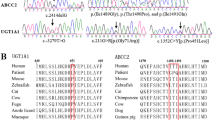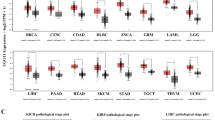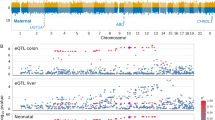Abstract
Prolonged unconjugated hyperbilirubinemia in infants associated with breast milk feeding is a common pediatric problem known as breast milk jaundice (BMJ). A polymorphic mutation (G71R) of bilirubin UDP-glucuronosyltransferase (UGT1A1) is a known cause of BMJ on the infantile side, but the responsible components of breast milk are not currently known. We analyzed the inhibitory effect of 5β-pregnane-3α,20β-diol (pregnanediol) on transcriptional activity and enzyme activity of UGT1A1. To this end, we constructed two types of expression vectors. One type comprised vectors including the upstream enhancer-promoter sequence of UGT1A1 for WT and variant type (-3279T>G with A(TA)7TAA), used in studying transcriptional regulation. The other type comprised vectors including cDNA of UGT1A1 for WT and the G71R variant, used in studying enzyme activity. In an in vitro expression study, pregnanediol did not affect the transcriptional activity of UGT1A1 enhancer-promoter complex of WT and variant type, even with coexistence of transcriptional factors such as constitutive androstane receptor or pregnane X receptor. In contrast, in the presence of 100 μM pregnanediol, bilirubin glucuronidation of G71R-UGT1A1 was reduced to 51% of WT. We suggest that pregnanediol is a cause of breast milk jaundice in carriers of G71R.
Similar content being viewed by others
Log in or create a free account to read this content
Gain free access to this article, as well as selected content from this journal and more on nature.com
or
Abbreviations
- BMJ:
-
breast milk jaundice
- CAR:
-
constitutive androstane receptor
- MEM:
-
minimal essential medium
- PXR:
-
pregnane X receptor
- UGT1A1:
-
bilirubin UDP-glucuronosyltransferase
References
Newman AJ, Gross S 1963 Hyperbilirubinemia in breast-fed infants. Pediatrics 32: 995–1001
Maisels MJ, Newman TB 1995 Kernicterus in otherwise healthy, breast-fed term newborns. Pediatrics 96: 730–733
Arias IM, Gartner LM 1964 Production of unconjugated hyperbilirubinemia in full-term new-born infants following administration of pregnane-3α,20β-diol. Nature 203: 1292–1293
Arias IM, Gartner LM, Seifter S, Furman M 1964 Prolonged neonatal unconjugated hyperbilirubinemia associated with breast feeding and a steroid, pregnane-3α,20β-diol, in maternal milk that inhibits glucuronide formation in vitro. J Clin Invest 43: 2037–2047
Adlard BP, Lathe GH 1970 Breast milk jaundice: Effect of 3α,20β-pregnanediol on bilirubin conjugation by human liver. Arch Dis Child 45: 186–189
Bevan BR, Holton JB 1972 Inhibition of bilirubin conjugation in rat liver slices by free fatty acids, with relevance to the problem of breast milk jaundice. Clin Chim Acta 41: 101–107
Hargreaves T 1973 Effect of fatty acids on bilirubin conjugation. Arch Dis Child 48: 446–450
Ramos A, Silverberg M, Stern M 1966 Pregnanediols and neonatal hyperbilirubinemia. Am J Dis Child 111: 353–356
Constantopoulos A, Messaritakis J, Matsaniotis N 1980 Breast milk jaundice: the role of lipoprotein lipase and the free fatty acids. Eur J Pediatr 134: 35–38
Gaffney PT, Buttenshaw RL, Ward M, Diplock RD 1986 Breast milk β-glucuronidase and neonatal jaundice. Lancet 1: 1161–1162
Bosma PJ, Seppen J, Goldhoorn B, Bakker C, Oude Elferink RP, Chowdhury JR, Chowdhury NR, Jansen PL 1994 Bilirubin UDP-glucuronosyltransferase 1 is the only relevant bilirubin glucuronidating isoform in man. J Biol Chem 269: 17960–17964
Sato H, Adachi Y, Koiwai O 1996 The genetic basis of Gilbert's syndrome. Lancet 347: 557–558
Aono S, Yamada Y, Keino H, Hanada N, Nakagawa T, Sasaoka Y, Yazawa T, Sato H, Koiwai O 1993 Identification of defect in the genes for bilirubin UDP-glucuronosyltransferase in a patient with Crigler-Najjar syndrome type II. Biochem Biophys Res Commun 197: 1239–1244
Maruo Y, Wada S, Yamamoto K, Sato H, Yamano T, Shimada M 1999 A case of anorexia nervosa with hyperbilirubinemia in a patient homozygous for a mutation in the bilirubin UDP-glucuronosyltransferase gene. Eur J Pediatr 158: 547–549
Monaghan G, Ryan M, Seddon R, Hume R, Burchell B 1996 Genetic variation in bilirubin UDP-glucuronosyltransferase gene promoter and Gilbert syndrome. Lancet 347: 578–581
Kadakol A, Ghosh SS, Sappal BS, Sharma G, Chowdhury JR, Chowdhury NR 2000 Genetic lesions of bilirubin uridine-disphosphoglucuronate glucuronosyltransferase (UGT1A1) causing Crigler-Najjar and Gilbert syndromes: correlation of genotype to phenotype. Hum Mutat 16: 297–306
Maruo Y, Nishizawa K, Sato H, Doida Y, Shimada M 1999 Association of neonatal hyperbilirubinemia with bilirubin UDP-glucuronosyltransferase polymorphism. Pediatrics 103: 1224–1227
Maruo Y, Nishizawa K, Sato H, Takahashi H, Shimada M 2000 Prolonged unconjugated hyperbilirubinemia associated with breast milk and mutations of the bilirubin uridine diphosphate-glucuronosyltransferase gene. Pediatrics 106: E59
Maruo Y, D'Addario C, Mori A, Iwai M, Takahashi H, Sato H, Takeuchi Y 2004 Two linked polymorphic mutations (A(TA)7TAA and T-3279G) of UGT1A1 as the principal cause of Gilbert syndrome. Hum Genet 115: 525–526
Sugatani J, Yamakawa K, Yoshinari K, Machida T, Takagi H, Mori M, Kakizaki S, Sueyoshi T, Negishi M, Miwa M 2002 Identification of a defect in the UGT1A1 gene promoter and its association with hyperbilirubinemia. Biochem Biophys Res Commun 292: 492–497
Sugatani J, Sueyoshi T, Negishi M, Miwa M 2005 Regulation of the human UGT1A1 gene by nuclear receptors constitutive active/androstane receptor, pregnane X receptor, and glucocorticoid receptor. Methods Enzymol 400: 92–104
Yoshinari K 2006 [Roles of nuclear receptors in the gene expression of drug-metabolizing enzymes under various physiological conditions]. Yakugaku Zasshi 126: 343–348
Xie W, Yeuh MF, Radominsha-Pandya A, Saini SP, Negishi Y, Bottroff BS, Cabrera GY, Tukey RH, Evans RM 2003 Control of steroid, heme, and carcinogen metabolism by nuclear pregnane X receptor and constitutive androstane receptor. Proc Natl Acad Sci U S A 100: 4150–4155
Huang W, Zhang J, Chua SS, Qatanani M, Han Y, Granata R, Moore DD 2003 Induction of bilirubin clearance by the constitutive androstane receptor (CAR). Proc Natl Acad Sci U S A 100: 4156–4161
Matsui K, Maruo Y, Sato H, Takeuchi Y 2010 Combined effect of regulatory polymorphisms on transcription of UGT1A1 as a cause of Gilbert syndrome. BMC Gastroenterol 10: 57–65
Auerbach SS, Ramsden R, Stoner MA, Verlinde C, Hassett C, Omiecinski CJ 2003 Alternatively spliced isoforms of the human constitutive androstane receptor. Nucleic Acids Res 31: 3194–3207
Lehmann JM, Mckee DD, Watson MA, Willson TM, Moore JT, Kliewer SA 1998 The human orphan nuclear receptor PXR is activated by compounds that regulate CYP3A4 gene expression and cause drug interactions. J Clin Invest 102: 1016–1023
Maruo Y, Serdaroglu E, Iwai M, Takahashi H, Mori A, Bak M, Calkavur S, Sato H, Takeuchi Y 2003 A novel missense mutation of bilirubin UDP-glucuronosyltransferase gene in a Turkish patient with Crigler-Najjar syndrome type1. J Pediatr Gastroenterol Nutr 37: 627–630
Ritter JK, Chen F, Sheen YY, Tran HM, Kimura S, Yeatman MT, Owens IS 1992 A novel complex locus UGT1 encodes human bilirubin, phenol, and other UDP-glucuronosyltransferase isozymes with identical carboxyl termini. J Biol Chem 267: 3257–3261
Sugatani J, Kojima H, Ueda A, Kakizaki S, Yoshinari K, Gong QH, Owens IS, Negishi M, Sueyoshi T 2001 The phenobarbital response enhancer module in the human bilirubin UDP-glucuronosyltransferase UGT1A1 gene and regulation by the nuclear CAR. Hepatology 33: 1232–1238
Buckley DB, Klaassen CD 2009 Induction of mouse UDP-glucuronosyltransferase mRNA expression in liver and intestine by activators of aryl-hydrocarbon receptor, constitutive androstane receptor, pregnane X receptor, peroxisome proliferator-activated receptor α, and nuclear factor erythroid 2-related factor 2. Drug Metab Dispos 37: 847–856
Onishi S, Kawade N, Itoh S, Isobe K, Sugiyama S 1979 Postnatal development of uridine diphosphate glucuronyltransferase activity towards bilirubin and 2-aminophenol in human liver. Biochem J 184: 705–707
Bancroft JD, Kreamer B, Gourley GR 1998 Gilbert syndrome accelerates development of neonatal jaundice. J Pediatr 132: 656–660
Monaghan G, McLellan A, McGeehan A, Li Volti S, Mollica F, Salemi I, Din Z, Cassidy A, Hume R, Burchell B 1999 Gilbert's syndrome is a contributory factor in prolonged unconjugated hyperbilirubinemia of the newborn. J Pediatr 134: 441–446
Fujiwara R, Nguyen N, Chen S, Tukey RH 2010 Developmental hyperbilirubinemia and CNS toxicity in mice humanized with the UDP-glucuronosyltransferase 1 (UGT1) locus. Proc Natl Acad Sci U S A 107: 5024–5029
Kulski JK, Smith M, Hartmann PE 1977 Perinatal concentrations of progesterone, lactose and alpha-lactalbumin in the mammary secretion of women. J Endocrinol 74: 509–510
Kulski JK, Hartmann PE 1981 Changes in the concentration of cortisol in milk during different stages of human lactation. Aust J Exp Biol Med Sci 59: 769–778
McGarrigle HH, Lachelin GC 1983 Oestrone, oestradiol and oestriol glucosiduronates and sulphates in human puerperal plasma and milk. J Steroid Biochem 18: 607–611
Severi F, Rondini G, Zaverio S, Vegni M 1970 Prolonged neonatal hyperbilirubinemia and pregnane-3(α),20(β)-diol in maternal milk. Helv Paediatr Acta 25: 517–521
Acknowledgements
We thank M. Suzaki of the Central Research Laboratory, Shiga University of Medical Science for technical assistance.
Author information
Authors and Affiliations
Corresponding author
Additional information
The authors report no conflicts of interest.
Rights and permissions
About this article
Cite this article
Ota, Y., Maruo, Y., Matsui, K. et al. Inhibitory Effect of 5β-Pregnane-3α,20β-Diol on Transcriptional Activity and Enzyme Activity of Human Bilirubin UDP-Glucuronosyltransferase. Pediatr Res 70, 453–457 (2011). https://doi.org/10.1203/PDR.0b013e31822f242e
Received:
Accepted:
Issue date:
DOI: https://doi.org/10.1203/PDR.0b013e31822f242e
This article is cited by
-
Gilbert or Crigler–Najjar syndrome? Neonatal severe unconjugated hyperbilirubinemia with P364L UGT1A1 homozygosity
Italian Journal of Pediatrics (2022)
-
Physiologically Based Pharmacokinetic Modeling Framework to Predict Neonatal Pharmacokinetics of Transplacentally Acquired Emtricitabine, Dolutegravir, and Raltegravir
Clinical Pharmacokinetics (2021)
-
Inherited disorders of bilirubin clearance
Pediatric Research (2016)
-
Contribution of UGT1A1 variations to chemotherapy-induced unconjugated hyperbilirubinemia in pediatric leukemia patients
Pediatric Research (2016)
-
Development of icterus gravis in a preterm infant with G71R UGT1A1 polymorphism
BMC Research Notes (2013)



